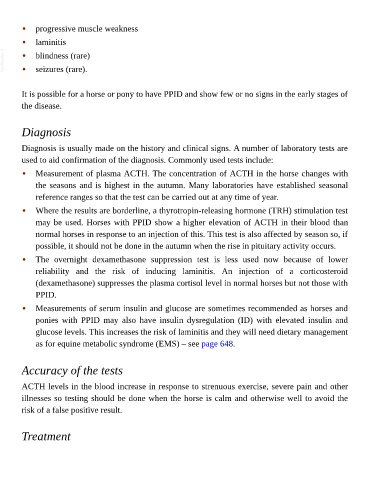Page 968 - The Veterinary Care of the Horse
P. 968
• progressive muscle weakness
• laminitis
VetBooks.ir • blindness (rare)
•
seizures (rare).
It is possible for a horse or pony to have PPID and show few or no signs in the early stages of
the disease.
Diagnosis
Diagnosis is usually made on the history and clinical signs. A number of laboratory tests are
used to aid confirmation of the diagnosis. Commonly used tests include:
• Measurement of plasma ACTH. The concentration of ACTH in the horse changes with
the seasons and is highest in the autumn. Many laboratories have established seasonal
reference ranges so that the test can be carried out at any time of year.
• Where the results are borderline, a thyrotropin-releasing hormone (TRH) stimulation test
may be used. Horses with PPID show a higher elevation of ACTH in their blood than
normal horses in response to an injection of this. This test is also affected by season so, if
possible, it should not be done in the autumn when the rise in pituitary activity occurs.
• The overnight dexamethasone suppression test is less used now because of lower
reliability and the risk of inducing laminitis. An injection of a corticosteroid
(dexamethasone) suppresses the plasma cortisol level in normal horses but not those with
PPID.
• Measurements of serum insulin and glucose are sometimes recommended as horses and
ponies with PPID may also have insulin dysregulation (ID) with elevated insulin and
glucose levels. This increases the risk of laminitis and they will need dietary management
as for equine metabolic syndrome (EMS) – see page 648.
Accuracy of the tests
ACTH levels in the blood increase in response to strenuous exercise, severe pain and other
illnesses so testing should be done when the horse is calm and otherwise well to avoid the
risk of a false positive result.
Treatment

